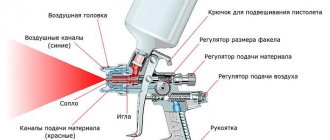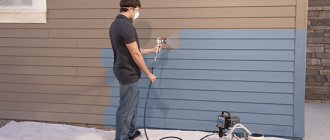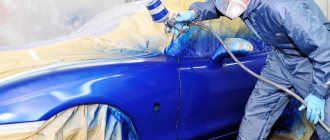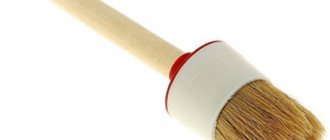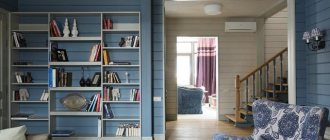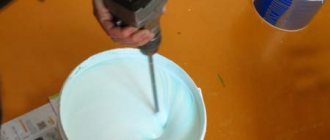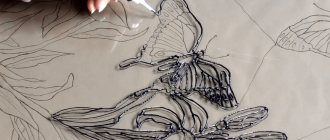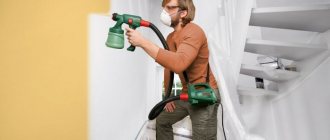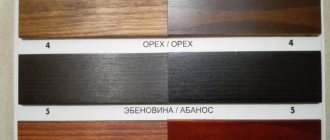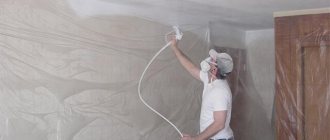Painting the facades of wooden houses is not an easy task. How to paint wood correctly in order to maintain its aesthetic appeal and so that the work does not turn out to be too difficult? The answer to the first part of the question presupposes knowledge of wood coloring technology, and the answer to the second question will be the use of special products for coloring wood.
A spray gun for painting wood can only be used if a translucent composition is not used.
Let's take a closer look at how to paint wood with a spray gun.
Painting features
Two types of spray guns are usually used:
- Pneumatic. Compressed air is supplied to the device, which passes through the internal channel and captures paint from a special container and flies out with force from the hole - the nozzle, creating a so-called paint torch. The circuit is distinguished by its quality and performance. The result largely depends on the experience and skill of the painter.
- Electric. To use an electric spray gun correctly when painting, you need to choose its type - with a compressor or with a plunger pump.
The compressor unit works on the same principle as the pneumatic one. The air pressure created by the built-in electric compressor is less than that of professional pneumatic devices. The quality of coloring is lower, but the consumption of the coloring mixture is also less.
Types of spray guns, their pros and cons
On the specialized market you can find mechanical, pneumatic and electric types of spray guns. The latter are also divided into air, plunger and battery subtypes.
Mechanical spray guns
This budget solution is usually used for whitewashing trees; its operating principle is similar to the primitive pumping chamber presented in a children's water pistol. The advantages of the model come down to low cost, ease of use and the ability to create a uniform layer. But there are also disadvantages, for example, manual air pumping and lack of accuracy. Such a spray causes a strong dispersion of the suspension.
Preparatory stage
Before painting it is necessary to carry out a number of operations.
- Surface preparation. The area to be painted is cleaned of dirt, washed and dried. The metal surface is degreased. Irregularities are processed with sandpaper.
- Preparing the paint. It is necessary to select the viscosity based on the diameter of the device nozzle and pressure. Viscosity is reduced by adding solvent. Enamel compositions are diluted to a ratio of 10 to 4, water-based emulsion - in a ratio of 10 to 1. Before use, the mixture is filtered.
- Test staining. Before starting work, a small area is painted. When applied, the composition should not bubble, leak or splash.
A few words about the manufacturers
So, choose an electric spray gun from well-known brands. Wagner painting tools are presented in a huge range, including painting stations for professional work and mobile hand tools. The main feature is the ability to adjust the pressure when applying a specific type of material. This ensures maximum streak-free paint quality in difficult areas such as corners, cornices and textured or patterned surfaces such as wood carvings or internal cavities.
Another German manufacturer, Bosch, produces a painting tool in a green casing. Household electric spray guns from this brand impress with their high speed of work, ease of use, compact body and, most importantly, affordable price.
Among tools for small-scale production and home use, BORT - one of the cheapest on the market. If the job needs to be done quickly and one-time, without particularly worrying about the service life of the tool, this is the best choice. Among the disadvantages of sprayers of this brand, users note that the piston jams when working with some types of paint. Therefore, you should pay attention to the list of recommended materials that the manufacturer indicates in the instructions.
Better assembled tools with protection from moisture and dust, STURM can work with paints, varnishes and primers. The built-in paint adjustment function allows you to customize the tools for different tasks.
Operating rules
There are several general rules for getting a good result:
- selection of spray distance. When using nitro-enamel and alkyd compositions, the optimal distance is 20-25 cm. For water-based emulsion - from 30 to 50 cm. In this case, the torch forms a color spot of maximum concentration, without smudges;
- holding the spray gun perpendicular to the surface while working. A deviation of 10% reduces the concentration of paint in the stain by 10-15%, which leads to its overuse.
Basic techniques for painting simple surfaces
You should start working with the spray gun from the corner of the plane. The unit is turned on 10-15 cm from the edge of the part and moves from left to right. When the right edge of the part is reached, the device turns off. The next stripe is applied lower than the previous one and overlaps it by about 50%. The process is repeated until the surface is completely painted.
For long parts, the sectional method is used. The surface is divided into several sections 65-90 cm long, which are painted separately. The boundaries of the sections overlap by 10-12 cm.
Painting and plastering of walls
- Painting the walls. It is carried out according to the rules for painting a vertical plane with division into sections. The sections are painted alternately, the edges overlap each other by 10-12 cm. If necessary, adjustments are made: the spray distance, pressure and size of the nozzle, and paint viscosity are changed. For the best color, the walls are painted in two layers. The second layer is applied after the first has completely dried.
- Wall putty. The viscosity of putty is higher than that of paint. To apply it, you need a device with a nozzle diameter from 3.5 mm to 8 mm. This type of pneumatic spray gun is called a cartouche gun. It has a large reservoir for the mixture and several replaceable nozzles of different diameters. To work, you need to paint with a spray gun with a compressor with a pressure of 3.5 - 4 atm. The technique of puttingty with a gun differs slightly from painting walls. The sections being processed are smaller in size - it is more convenient to work with a heavy gun, the spraying distance is 15-20 cm, you may need a hand spatula to eliminate defects.
- Applying a fur coat. Textured plaster (fur coat) is an effective and practical wall decor. It is applied with a cartouche gun with nozzles with a diameter of 6 mm to 8 mm. The application method is similar to putty. The spraying distance is 10-15 cm, and when using gypsum plaster it is reduced to 5-10 cm. The wall is processed sectionally, from top to bottom from left to right. Layer thickness – no more than 12 mm.
Interior and furniture protection
Using a spray gun requires more than just protecting the edges with masking tape, as you would with a roller. You should also protect with film every thing you don't want to get paint on - windows, floors, ceilings and furniture. The time you save by spray painting is not worth the heartache when you discover that the protection wasn't as thorough. Just know that if you are painting outside, a sprayer is not the best option for a windy day.
Photography - unsplash
Safety precautions when working
During operation it is necessary:
- observe electrical safety measures;
- work in a ventilated area;
- use protective equipment: respirator, goggles, gloves, overalls;
- When working at height, use special devices: stepladder, stable sawhorses, etc. A prerequisite is an assistant for insurance.
Sanding timber
Painting the outside of a wooden house is intended not only to create a beautiful exterior, but also to increase the protective function
Most people think that having bought a log house, they can immediately get to work and paint the house. But it is worth noting that this is a huge misconception. In order to ensure a good joint between the materials, the wood must be pre-treated. This action will help avoid dampness and destruction of the timber.
The first thing that is important for any developer is to ensure the protection of the walls in a wooden house. This way, you can extend the service life of the material, and your home will have a beautiful appearance, as in the photo. To achieve this effect, you can use specialized substances or paint wooden products.
In order to paint the walls of a wooden house correctly, you should take a responsible approach to the choice of materials for the work. The dyeing technology is quite simple, so there is no need to involve specialists. There are some rules for the process, after studying which you will cope with the task no worse than the masters.
Cleaning the spray gun
The device must be cleaned after each use in the following sequence:
- unscrew and rinse the container;
- the air cap and nozzle are removed and washed;
- the air distribution ring is removed and cleaned with the brush supplied with the device, without using a solvent;
- the needle is removed and washed;
- use a brush to clean the air channels of the device;
- the device is blown with compressed air or wiped dry with a clean rag;
- Upon completion of cleaning, the unit is assembled and put away for storage.
Source
How to protect walls when painting the ceiling?
Secondly, the ceiling around the perimeter must be protected with masking tape. After painting or pasting the walls, the tape can be easily removed without leaving any traces. If a few drops of glue or paint do get onto the stretch fabric, they must be wiped off immediately.
Interesting materials:
How many hours a day can you do repairs? How many people can be temporarily registered? How long does 2 personal income tax apply to a mortgage? How long is a US visa valid? How long is a car purchase and sale agreement valid for 2022? How long is a power of attorney valid if no period is specified? How long does DS 160 last? How long is a receipt for payment for a Ukraine international passport valid? How long is a medical certificate valid for obtaining a driver's license? How long is the tax deduction valid when buying an apartment?
Instructions: how to properly paint wood with a spray gun
Painting the facades of wooden houses is not an easy task. How to paint wood correctly in order to maintain its aesthetic appeal and so that the work does not turn out to be too difficult? The answer to the first part of the question presupposes knowledge of wood coloring technology, and the answer to the second question will be the use of special products for coloring wood.
A spray gun for painting wood can only be used if a translucent composition is not used.
Let's take a closer look at how to paint wood with a spray gun.
Selection of materials
Most modern varnishes are perfect for any type of wood. Therefore, they are successfully used in the mass production of wooden furniture and the design of decorative elements. In practice, the following types of varnish compositions are used:
- Oily. Usually contain synthetic or natural resins. The latter are characterized by a considerable price and are environmentally friendly. After applying such products, a film is formed that protects the surface from moisture.
- Polyurethane. High-quality, as a result of wood coating they form a durable protective layer. This composition is most often used in construction and in the manufacture of many musical instruments.
- Alkyd. Manufactured using synthetic resins and containing a solvent. They are versatile and suitable for covering any wood.
- Acrylic. The main advantage is environmental friendliness. The applied layer makes the base more durable and protects it from moisture. This material is intended for interior work: finishing the ceiling, walls of living rooms.
- Primers. Colorless compositions contain natural oil, after application they prevent the formation of mold and mildew. It is allowed to varnish windows from the outside and entrance doors from the inside.
Article on the topic: Is it possible to install LED spots in the ceiling of a wooden house?
Modern means can protect even wood that is constantly in water.
Preparing wood for painting
Before painting over the natural nature of the wood, you need to carefully examine it for the absence of rotting and various sores.
Before painting, the wood must be treated: imperfections must be filled, treated with sandpaper, and then sanded.
Identified “weak” areas must be treated before painting. For example, there is a trace left from a nail or metal fastener that was once driven in, which radically disturbed both the color of the wood and its structure in this area. Or a dent, a chip, a fallen or “live” knot has been discovered. Such places are subject to repair, even if non-transparent painting over the entire surface is planned. Why can’t such places be left unfixed? Because the wood itself consists of a structure that is heterogeneous in density (young and late wood) and has a relief. And even under the finishing, the natural texture (pattern) of the wood is visible, which is advisable to take advantage of when painting the wood.
The putty surface is sanded using fine-grained sandpaper, which contributes to the appearance of minimal lint. It is recommended to prime softwood, “fixing” the pile. After which you can perform final sanding. The pile is sanded during all intermediate dyeing procedures.
Professional
A wooden house will be painted efficiently and beautifully if you use the services of our company. All our craftsmen are specialists with extensive experience, have specialized education, and master the intricacies of working with wood. Do you need to paint a small country house or a huge country mansion? This is for us! We will complete all stages of work of any volume in the shortest possible time, with consistently high quality, at an affordable cost. You can submit a request to call a specialist directly on the website if you visit the “Contacts” section.
Article on the topic: How to choose a metal entrance door to a wooden house
Calculate the cost of painting and insulating your home right now
Features of painting wood
Before you start painting wood, you need to remember such a property of it as uneven absorption of paint by different areas. That is, soft layers look matte after painting, while denser ones look shiny. This effect is enhanced by affecting the texture with stain and applying varnish protection. Sometimes they use tinting varnishes, which reveal the texture and color the wood. Wood as a material is universal, which is very noticeable when using coloring agents, when it is possible to completely recreate the structure of another, more valuable species.
Painting a facade with a spray gun can significantly reduce work time, the paint goes on more evenly and dries faster.
By using opaque compounds, they strive to achieve a different effect, for example, when painting oak. With high density and a pronounced texture, it absorbs the coating, but continues to retain the texture due to the relief. After preparing the surface of the oak (by cleaning and priming), the oak is painted with white paint and then sanded. Re-exposing the natural color of the wood, the paint can be seen remaining in soft layers, embodied in a unique combination of shades called "gray" oak. The perception will be completely opposite from the lightening of the veins and from the appearance of oak veins.
Roller - the choice of the economical homeowner
Affordable entry-level spray guns start at $100, and most quality brands cost you double your hard-earned money. Even renting a sprayer can cost good money. If you decide to use a spray gun anyway, you'll have to buy more paint: sprayers use about 33 percent more paint than a roller. Therefore, a roller is a more budget-friendly method of painting.
Photography - unsplash
Using a spray gun
Diagram of the spray gun device.
Naturally, it will be much easier to paint a façade surface of 50 m² if you have specialized equipment, which includes a spray gun. How justified is the use of a spray gun in painting the outside of wooden walls of houses - let's clarify.
The spray gun has a reputation as a professional painting equipment for a reason. It is used in their work by professional painters in a wide variety of fields: from tire fitting to restoration services of antique furniture. The quality of coating application is ensured by pneumatic spraying through finely dispersed crushing of the paint composition. However, this technology applies only to a small area of painting. With a wall area of 50 m², it is absolutely impossible to prevent sagging and overlaps. Moreover, even an experienced painter will be able to paint with a spray gun. The main problem in this case is the inter-crown joints. At the joints, overlaps and excess paint are formed even with the adjusted width of the spray torch. It is very important to maintain the same distance between the wall surface and the spray gun; the speed of movement of the spray gun should also be the same.
The use of a paint sprayer is absolutely unacceptable for the use of translucent compounds. But for opaque painting of the facade, it is possible to use a spray gun, since when the paint is applied opaquely, the overlaps become invisible.
How to paint a wooden house outside: choice of material and application technology
When deciding how to paint the outside of a wooden house, it is important to decide on the choice of surface: glossy or matte, structured or smooth, tinted or preserving the natural color. An important aspect is surface preparation. In this case, you should figure out whether the material will be applied to the old coating or to the new frame. Paints differ in performance properties, composition, etc.
Painting a wooden facade
To choose the right exterior finish, it is important to know the main characteristics of the materials used:
- Antiseptic.
- Acrylic composition.
- Oil coating.
- Alkyd material.
- Rubber paint.
Antiseptic compounds
Attention!
The antiseptic has increased penetrating properties.
The level of impregnation reaches up to 4-7 mm. This provides reliable protection against wood damage in all its forms.
Painting external wooden walls
When understanding the dilemma of how to paint the outside of a wooden house, it is important to consider that in addition to its protective properties, antiseptics are used for transparent tinting and decorative finishing of coatings. They are produced in the form of coating and glazing materials. The second type has a transparent design, which affects the preservation of the texture of the array and gives it a noble, natural tone.
Article on the topic: Which houses are made of profiled timber
Opaque bioprotection is successfully used when it is necessary to hide the texture of wood while maintaining its relief.
Acrylic composition
So, the choice of composition leans towards weather resistance and preservation of the natural shade. Acrylic material is breathable. At the same time, it is valued for its elastic properties, environmental friendliness and brilliant effect. The basis of the material is aqueous composition, and the binding elements are acrylates.
When applying the coating, you don't have to worry about odor or clogged pores. The paint is not afraid of moisture, temperature changes and UV rays.
Painting a wooden structure
Acrylic paint mixes well with other compounds and is easily applied using a roller, brush or spray. It dries quickly and is applied over the old layer.
Oil coating
An excellent option for creating a weather-resistant surface with an increased level of adhesion. Products take a long time to dry, change color over time and can peel off during prolonged use.
Alkyd product
If you have already decided what color to paint the outside of a wooden house, you can choose a series of budget options that were among the first to hit the market. They form a thin film after drying, which serves as reliable protection against liquid media. Quick drying and low penetration result in a short service life.
Applying paint to a timber façade
Attention!
When choosing a manufacturer, it is recommended to pay attention to the products of Tikkurila, Teknos, REESA and TEX.
Spray gun for painting a house
The following material was published to help those who do not know how to paint the outside of a wooden house with a spray gun. To ensure even paint atomization and uniform application, it is important to move the nozzle at an equal distance from the coating and at a constant speed. It is important to avoid overlapping layers and drips at the joints. You can work effectively in hard-to-reach places only with a regular brush.
Article on the topic: Ahead was a wooden house with a mezzanine, a red roof and wild walls whose house
The use of a spray gun ensures savings in material consumption. A respirator is used as protective equipment.
The spray gun itself looks like a pistol. A hose with compressed air is supplied to its handle. A container of paint is screwed into the upper or lower part. At the end of the gun there is a replaceable spray head.
Painting a wooden building outside
There is a trigger at the bottom of the gun to open the air valve when pressed. The body of the product consists of aluminum with a nickel coating. It protects against alloy corrosion and rust.
Preparing the spray gun for work
- To regulate the flow of air and paint, the sprayer is suspended in a vertical position above a piece of newspaper and held at some distance from it.
- Press down on the trigger and do not release it until streaks form on the paint spot.
- The settings are adjusted.
- The air nozzle is turned so that a torch resembling a fan is formed.
- You need to practice spraying continuous stripes with overlaps in different directions.
- To create a uniform coating, the tool is moved at the same speed, maintaining a certain distance to the wall.
- Having gained a little experience in using the device, they move on to directly spraying paint on the facade walls.
- First, determine the order of spraying paint on the surface of the facade. The facade is divided into several zones, highlighting one with higher priority.
- You need to paint in zones, starting with the last one.
- The trigger is pulled at the edge of the wall, but not before it begins. The sprayer must not be tilted. No need to move it in waves. The trigger is released when the torch begins to capture the opposite surface boundary.
Thus, you can paint the wooden facade of a small country house with a spray gun. The main thing is not to use translucent compounds for this. The technology is chosen according to the type of covering finish, when the wall is thickly painted with an opaque composition in order to eliminate the appearance of overlaps.
Source
Tinting
The preparatory stage is the most tedious in the varnishing process. When finished, carefully remove wood dust from the surface of the canvas. Then, from the lower and upper ends, a pair of nails 150-200 mm are driven into the door to a depth sufficient to hold it on the painting trestles (this is for sure, 3-4 centimeters). They are driven in at such a distance that the door on the trestles can be conveniently turned over.
On a note. If you drive in three nails (two on the sides of the lower end, one in the middle of the upper), the trestle door can be turned over without a partner.
Before use, it doesn’t matter whether it’s varnish or stain, they are filtered. This can be done by taking old women's tights and putting them on a container of varnish. I hope there won't be any problems with this.
dish sponge is better suited for these purposes . It is used to rub the stain into the wood and remove excess. Try how it lays down and dries on an unnecessary block, then move on to the “finishing” part.
If necessary, apply several layers of stain and wait until it dries completely. Then the door is very carefully sanded with fine (P240) sandpaper and a second layer is applied.
Attention! After the last layer of stain, the wood is not sanded; the first layer of varnish is immediately applied to consolidate the result.
Painting the facade of a house with your own hands: features of painting with a spray gun, options, and photos
Painting the facade of a house with your own hands: types of paints and painting features
If you want the façade of your house to last for a long time without much repair, it is necessary to periodically carry out its maintenance and renovation. One of the most practical ways is to paint the facades of houses and cottages with your own hands.
They can be anything - brick, concrete, wood or plastered, the main thing is to choose the right paint and prepare the facade for finishing.
Options for painting the facade of a house with a roller
Requirements
At first glance, painting facades is not particularly difficult. You can take any paint in the required quantity and apply it to the walls in several layers. At this stage, most home craftsmen fail, or rather after some time. The paint, having not lasted even a couple of seasons, begins to lose its original color, cracks or completely flies off the facade.
Acrylic paint for facade
The answer in this case is simple - a material was used that was not intended for such work.
The technology for painting facades involves the use of special facade paint, which must meet certain requirements, in particular it must:
- Be resistant to external influences, including:
- wind;
- moisture;
- precipitation;
- mechanical damage.
- Calmly tolerate sudden changes in temperature.
Often in the regions of our country the thermometer can drop below -30˚ C, or stay above +40˚ C for a long time. Agree, not every paint can withstand such harsh conditions without losing its performance properties. Painting a house with water-based facade paint
- Do not change its original color due to ultraviolet radiation, i.e. remain unchanged during prolonged exposure to bright sunlight.
- Match the material from which the façade of the house is made. For example:
- a brick façade is best painted with acrylic-based latex paint, which has high vapor permeability;
- for finishing a wooden facade - a special water-dispersion one;
- for concrete – water-based acrylic paint such as “AKVABETOL” or similar.
Advice: if you are not satisfied with the cost of painting the facade of the house, do the work yourself, saving almost half the price.
Fireproof material for painting facades
Types of facade paints
Exterior walls can be painted using a variety of paints.
Today they are most often used for the following purposes:
- acrylic;
- based on PVA;
- butadiene styrene.
Let's take a closer look at each of the products presented above.
Then you can immediately understand which option is most suitable for your walls:
- PVA-based materials are not used so often, but they have the most affordable price. Their main drawback is that they are afraid of water;
- Unlike the previous product, styrene-butadiene paints have excellent moisture resistance. But they have another drawback - they cannot withstand UV radiation for long and begin to lose their original color;
- All parameters of acrylic paints are at a high performance level, allowing them to be used most effectively when painting any facades of industrial and residential buildings. The only significant drawback that may affect your choice is the high cost of the product.
In the photo - silicone-based exterior paint
Tip: when using acrylic paints for exterior work, the walls receive a “breathing” effect, due to which excess moisture will not accumulate in the walls and their service life will increase significantly.
From the above, it became clear that various paints can be used to paint building facades. However, you need to learn how to select them correctly for the appropriate walls.
Latex-based butadiene styrene paint
How to paint a facade correctly
When painting, you will have to use a three-component material application system.
- The first layer is priming the surface, in particular, the wooden facade should be covered with anti-resin material, which prevents stains from forming and blocks the appearance of resins.
- The second is designed to protect the base from fungus, insects and bacteria.
- The third is a dye of the required color, which helps the facade to withstand adverse environmental influences.
Tip: Cover areas of external walls that do not require painting with masking tape, paper or other materials.
Don't forget to treat all metal elements and nail heads with a special anti-corrosion primer.
In fact, you will need to carry out the same work as when painting the interior. Only in this case there will be significantly fewer of them.
Tip: cover the glass with plywood or wet the surface and apply newspaper. You can also use a homemade mixture of lubricant and soap.
Do-it-yourself painting of the house facade with a spray gun
Recommendations
Don’t forget – quality work can only be obtained from a quality tool:
- for water-based paints, prepare synthetic rollers and paint brushes;
- For paints containing organic solvents, it is better to prepare brushes from natural materials.
Remember, the instructions printed on the packaging label are guidelines for implementation. Do not deviate from it if you want to get the desired result.
Advice: if you doubt your abilities, then contact the appropriate company, where they will immediately tell you how much it costs to paint the facade of a house, and also determine the work schedule.
Conclusion
Painting the external walls of buildings makes it possible to protect the main materials of the structure from various mechanical and atmospheric influences. Before you start painting, you need to choose the right material that will fit the given criteria.
Today, the home craftsman has a wide range of paints for various purposes at his disposal. This article will help you find additional information on this topic.
https://nashaotdelka.ru
legkoe-delo.ru
Preparing the wood surface for varnishing
Before coating the wood with varnish, it is necessary to carefully prepare the material for work, then the layer will be beautiful and smooth, and no flaws will be visible. They start with preparing tools and materials. The wooden surface is cleaned; it is important to remove all previous coatings.
It will not be possible to restore wood in separate areas; full coverage is carried out.
The following equipment will be required:
- Brushes for hard-to-reach areas and rollers if the area is large;
- Sandpaper or sander to remove old coatings and level the base;
- Brush or vacuum cleaner to get rid of accumulated dust.
The following options are available for cleaning the surface from previous materials:
- Chemical, special chemicals are used;
- Mechanical, performed with sandpaper or a grinding device;
- Thermal, together with mechanical, after heating the surface, mechanical devices are used.
The wooden surface is cleaned; it is important to remove all previous coatings.
Typical mistakes in varnishing wood
When working with your own hands, it is easy to make mistakes, so it is advisable to study the typical ones in advance. Experts highlight the following points:
- Poor drying of the layer, usually due to a violation of the temperature regime, or when the product was chosen incorrectly. For two-component varnishes, this result is explained by the addition of an insufficient amount of hardener;
- If white stains remain, then the humidity in the room was increased, which caused a similar effect;
- The appearance of bubbles and swelling of the layer is due to improper distribution of the varnish over the wooden surface;
- Uneven coverage and uneven shade. The result is associated with the lack of skills of the master. If the varnish is quick-drying, then you may not have time to apply the layer on time.
Uneven coverage and uneven shade. The result is associated with the lack of skills of the master.
Varnishing wood helps create an attractive shade, as well as a barrier from negative factors and preserve the natural pattern of the material. You need to choose the right varnish that suits the working conditions. The technology of the process includes nuances, ignorance of which can lead to negative consequences; careful reading of the article will help to avoid mistakes.
Causes of wood destruction
A material such as wood has a short service life, as it is susceptible to negative environmental influences.
A material such as wood has a short service life, as it is susceptible to negative environmental influences. It is for this reason that it is necessary to further process it. In order to protect the material from destruction, you need to know the reasons why wood is destroyed. So, this phenomenon can occur under the following circumstances:
Painting the ceiling with water-based paint using a spray gun and its cost
- Logs age over time;
- Exposure to atmospheric precipitation produces a destructive effect on the building within two years if no treatment is carried out;
- Wood easily absorbs moisture, which leads to the expansion of pores, which, when dry, narrow and cracks appear;
- Parasites and bark beetles love this material very much, so they very often settle inside boards and logs. It is worth noting that they have the maximum negative impact on the strength of the material.
- If the building is located near a water source or natural reservoir, then the speed of the destructive process increases.
Attention! In order to preserve your building, you should paint the outer facade.
Benefits of External Painting
When the preparation of the wooden product is completed, you can begin painting the outer facade
When the preparation of the wooden product is completed, you can begin painting the outer facade. It is best to give preference to acrylic types of paints. The selected material for processing is the ideal color scheme. The coloring of the building has the following advantages:
- The use of paint enhances the protective functions of the material;
- The painted material does not become damp or rot;
- Painting wooden houses will protect them from harmful insects, fungal and corrosive processes;
- Paint makes it possible to experiment with a design solution, so you can choose any photo with a beautiful interior and choose the colors you need.
- If you come to change the color, you can repaint the facade at any time.
